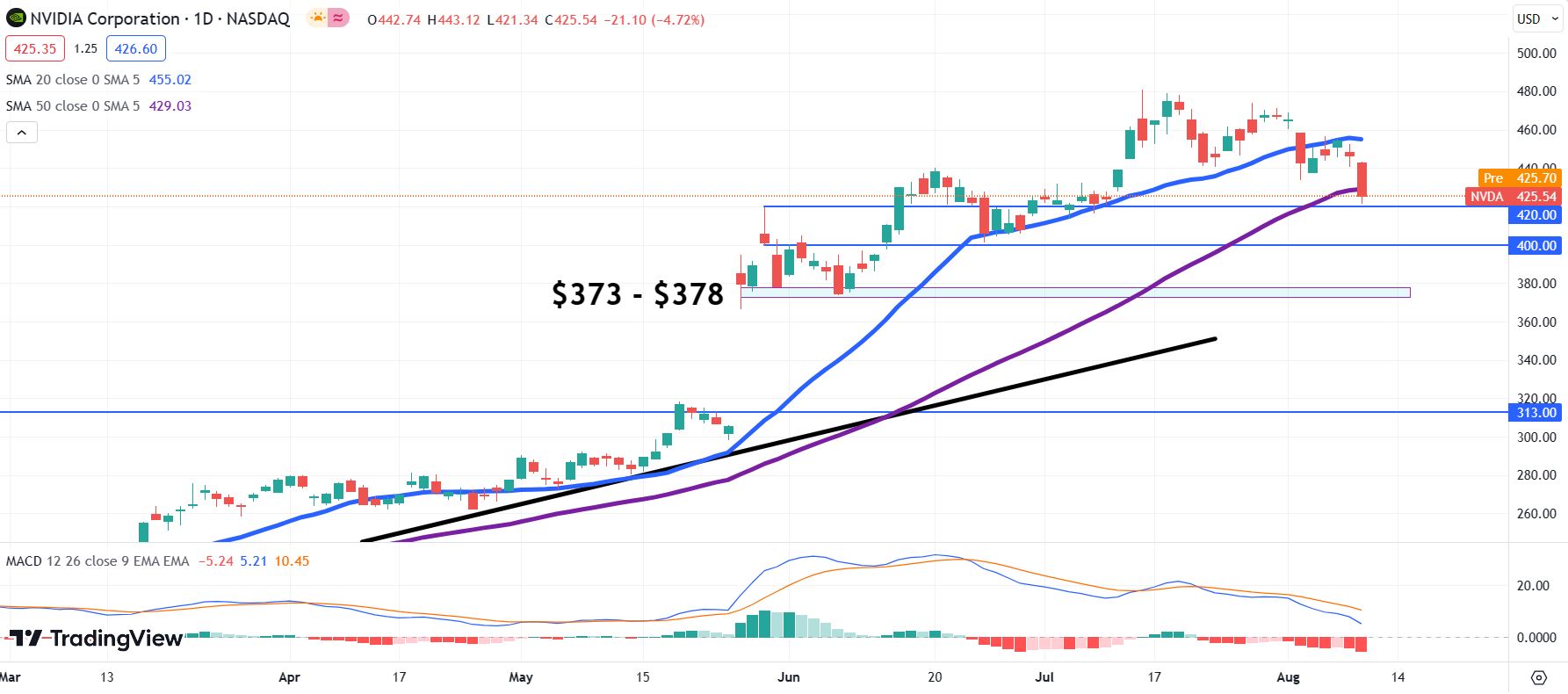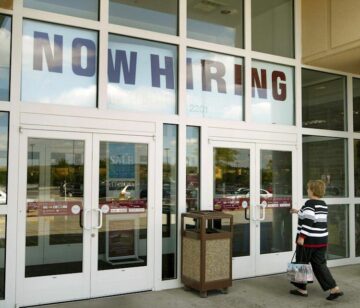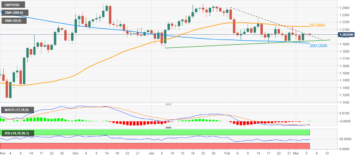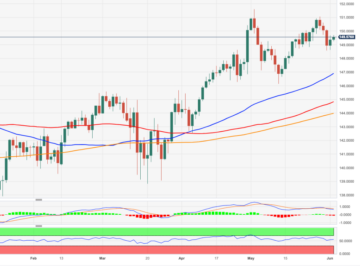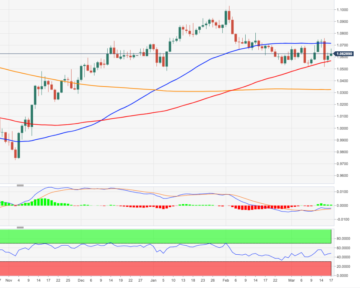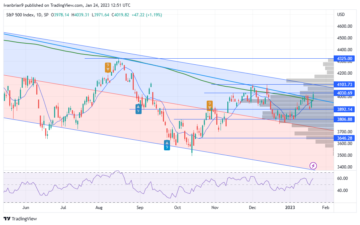- NVDA stock traded higher on Thursday after US CPI data undershot expectations.
- This came after weakness suffered on Wednesday following Biden semiconductor export limits.
- NASDAQ 100 futures rose 1.1% early Thursday on CPI beat.
- Chinese tech giants have at least $9 billion worth of orders for Nvidia’s A800 GPU.
Nvidia (NVDA) stock reversed course and moved above the 50-day Simple Moving Average (SMA) temporarily on Thursday after the US Consumer Price Index (CPI) for July came in below expectations. The result especially boosted tech stocks, and the NASDAQ Composite jumped 1.6% on the news.
Core CPI rose 4.7% YoY, and headline inflation gained 3.2% YoY. Both readings were 10 basis points below consensus.
Nvidia, a leading AI-chip manufacturer, dropped 4.7% on Wednesday following news that US President Joe Biden has signed an executive order to limit investment by US corporations in specific Chinese hi-tech industries, that constitute a core segment of Nvidia’s market.
Nvidia stock news: Biden administration to limit Chinese investment
Wednesday afternoon the Biden administration adopted an executive order that would limit US corporations from investing in the semiconductor, microelectronic, quantum information technology, and artificial intelligence industries of China. The latter’s foreign ministry decried the new stringent regulations.
“This program will seek to prevent foreign countries of concern from exploiting U.S. investment in this narrow set of technologies that are critical to support their development of military, intelligence, surveillance, and cyber-enabled capabilities that risk US national security,” the White House said in a written statement.
The Financial Times simultaneously reported that Chinese heavyweights in the consumer internet sector have ordered more than $5 billion worth of Nvidia chips in an attempt to stockpile them ahead of a more restrictive environment. Those tech companies include Alibaba (BABA), Tencent (TCEHY), Baidu (BIDU) and ByteDance – which all have orders for upwards of $1 billion worth of A800 GPUs with delivery timelines in 2023. For 2024, they have at least another $4 billion worth of orders already penciled in.
Nvidia designed the A800 last year in order to circumvent rules from Washington regarding state-of-the-art semiconductor technology headed to China. The A800 has a slower transfer rate than the A100 it is modeled on that is used in data centers to deal with the heavy compute required for training large language models and other generative AI technologies.
On Monday, a Morgan Stanley team released a client note arguing that the AI rally this year is in its “later innings”. Noting that Nvidia and other prominent AI-related stocks have more than tripled their share prices year to date, the team captained by equity strategist Edward Stanley said that this rally had already surpassed other niche bubbles that on average see gains of 150% over a three-year period.
Citi reiterated its Buy rating and $560 price target on NVDA stock on Wednesday following Nvidia’s unveiling of its GH200 Grace-Hopper superchip. The chip platform comes with triple the bandwidth and memory of the most recent generation of chips and is designed to deal with heavier generative AI workloads at data centers.
Nvidia is slated to report second-quarter earnings on August 23. After the company raised its outlook last quarter, Wall Street analysts now expected adjusted earnings per share (EPS) of $2.07 on revenues of $11.06 billion.
Nvidia FAQs
Nvidia is the leading fabless designer of graphics processing units or GPUs. These sophisticated devices allow computers to better process graphics for display interfaces by accelerating computer memory and RAM. This is especially true in the world of video games, where Nvidia graphics cards became a mainstay of the industry. Additionally, Nvidia is well-known as the creator of its CUDA API that allows developers to create software for a number of industries using its parallel computing platform. Nvidia chips are leading products in the data center, supercomputing and artificial intelligence industries. The company is also viewed as one of the inventors of the system-on-a-chip design.
Current CEO Jensen Huang founded Nvidia with Chris Malachowsky and Curtis Priem in 1993. All three founders were semiconductor engineers, who had previously worked at AMD, Sun Microsystems, IBM and Hewlett-Packard. The team set out to build more proficient GPUs than currently existed in the market and largely succeeded by late 1990s. The company was founded with $40,000 but secured $20 million in funding from Sequoia Capital venture fund early on. Nvidia went public in 1999 under the ticker NVDA. Nvidia became a leading designer of chips to the data center, PC, automotive and mobile markets through its close relationship with Taiwan Semiconductor.
In 2022, Nvidia released its ninth-generation data center GPU called the H100. This GPU is specifically designed with the needs of artificial intelligence applications in mind. For instance, OpenAI’s ChatGPT and GPT-4 large language models (LLMs) rely on the H100’s high efficiency in parallel processing to execute a high number of commands quickly. The chip is said to speed up networks by six times Nvidia’s previous A100 chip and is based on the new Hopper architecture. The H100 chip contains 80 billion transistors. Nvidia’s market cap reached $1 trillion in May 2023 largely on the promise of its H100 chip becoming the “picks and shovels” of the coming AI revolution.
Long-time CEO Jense Huang has a cult following in Silicon Valley and on Wall Street due to his strict loyalty and determination to build Nvidia into one of the world’s leading companies. Nvidia neary fell apart on several occasions, but each time Huang bet everything on a new technology that turned out to be the ticket to the company’s success. Huang is seen as a visionary in Silicon Valley, and his company is at the forefront of most major breakthroughs in computer processing. Huang is known for his enthusiastic keynote addresses at annual Nvidia GTC conferences, as well as his love of black leather jackets and Denny’s, the fast food chain where the company was founded.
Nvidia stock forecast: A break of 50-day SMA speaks volumes
As previously mentioned, NVDA stock closed below the 50-day SMA on Wednesday. It has traded above this moving average since January 9, so that works out to roughly an 8-month uptrend.
Nvidia stock had to consolidate at some point, and there are plenty of support levels nearby that might serve as decent entries for longs. It is now trading right near the $420 price level that served as both resistance (May 30) and support (June and July). The $400 level worked as support on several occasions from May 30 through June 26, and below there comes the demand zone stretching from $373 to $378.
The Moving Average Convergence Divergence (MACD) began its bearish turn lower in late June and it could soon trend below the zero threshold, which would be a much stronger bearish warning for bulls. In mid-July, Nvidia stock ran into stubborn resistance just around $480.
NVDA daily chart
Nvidia FAQs
Nvidia is the leading fabless designer of graphics processing units or GPUs. These sophisticated devices allow computers to better process graphics for display interfaces by accelerating computer memory and RAM. This is especially true in the world of video games, where Nvidia graphics cards became a mainstay of the industry. Additionally, Nvidia is well-known as the creator of its CUDA API that allows developers to create software for a number of industries using its parallel computing platform. Nvidia chips are leading products in the data center, supercomputing and artificial intelligence industries. The company is also viewed as one of the inventors of the system-on-a-chip design.
Current CEO Jensen Huang founded Nvidia with Chris Malachowsky and Curtis Priem in 1993. All three founders were semiconductor engineers, who had previously worked at AMD, Sun Microsystems, IBM and Hewlett-Packard. The team set out to build more proficient GPUs than currently existed in the market and largely succeeded by late 1990s. The company was founded with $40,000 but secured $20 million in funding from Sequoia Capital venture fund early on. Nvidia went public in 1999 under the ticker NVDA. Nvidia became a leading designer of chips to the data center, PC, automotive and mobile markets through its close relationship with Taiwan Semiconductor.
In 2022, Nvidia released its ninth-generation data center GPU called the H100. This GPU is specifically designed with the needs of artificial intelligence applications in mind. For instance, OpenAI’s ChatGPT and GPT-4 large language models (LLMs) rely on the H100’s high efficiency in parallel processing to execute a high number of commands quickly. The chip is said to speed up networks by six times Nvidia’s previous A100 chip and is based on the new Hopper architecture. The H100 chip contains 80 billion transistors. Nvidia’s market cap reached $1 trillion in May 2023 largely on the promise of its H100 chip becoming the “picks and shovels” of the coming AI revolution.
Long-time CEO Jense Huang has a cult following in Silicon Valley and on Wall Street due to his strict loyalty and determination to build Nvidia into one of the world’s leading companies. Nvidia neary fell apart on several occasions, but each time Huang bet everything on a new technology that turned out to be the ticket to the company’s success. Huang is seen as a visionary in Silicon Valley, and his company is at the forefront of most major breakthroughs in computer processing. Huang is known for his enthusiastic keynote addresses at annual Nvidia GTC conferences, as well as his love of black leather jackets and Denny’s, the fast food chain where the company was founded.
- SEO Powered Content & PR Distribution. Get Amplified Today.
- PlatoData.Network Vertical Generative Ai. Empower Yourself. Access Here.
- PlatoAiStream. Web3 Intelligence. Knowledge Amplified. Access Here.
- PlatoESG. Automotive / EVs, Carbon, CleanTech, Energy, Environment, Solar, Waste Management. Access Here.
- PlatoHealth. Biotech and Clinical Trials Intelligence. Access Here.
- ChartPrime. Elevate your Trading Game with ChartPrime. Access Here.
- BlockOffsets. Modernizing Environmental Offset Ownership. Access Here.
- Source: https://www.fxstreet.com/news/nvidia-stock-forecast-nvda-breaks-below-50-day-sma-202308101257
- :has
- :is
- :where
- $1 billion
- $9 Billion
- $UP
- 000
- 07
- 1
- 10
- 100
- 1999
- 2%
- 2022
- 2023
- 2024
- 23
- 26
- 30
- 32
- 33
- 36
- 80
- 9
- a
- A100
- above
- accelerating
- Additionally
- addresses
- Adjusted
- administration
- adopted
- After
- ahead
- AI
- All
- allow
- allows
- already
- also
- AMD
- an
- Analysts
- and
- Animate
- annual
- Another
- apart
- api
- applications
- architecture
- ARE
- around
- artificial
- artificial intelligence
- AS
- At
- AUGUST
- automotive
- average
- back
- Bandwidth
- based
- basis
- BE
- bearish
- became
- becoming
- began
- below
- Bet
- Better
- biden
- Biden Administration
- Billion
- Black
- Boosted
- both
- Break
- breakthroughs
- build
- Bulls
- but
- buy
- by
- called
- came
- cap
- capabilities
- capital
- Cards
- Center
- Centers
- ceo
- chain
- Chart
- ChatGPT
- China
- chinese
- chip
- Chips
- Chris
- client
- Close
- closed
- comes
- coming
- Companies
- company
- Company’s
- Compute
- computer
- computers
- computing
- Concern
- conferences
- Consensus
- consolidate
- constitute
- consumer
- consumer internet
- contains
- content
- Convergence
- Core
- Corporations
- could
- countries
- course
- CPI
- CPI data
- create
- creator
- critical
- cult
- Currently
- daily
- data
- Data Center
- data centers
- Date
- deal
- delivery
- Demand
- Design
- designed
- Designer
- determination
- developers
- Development
- Devices
- Display
- Divergence
- due
- each
- Early
- Earnings
- Edward
- efficiency
- ends
- Engineers
- enthusiastic
- Environment
- equity
- especially
- Ether (ETH)
- everything
- execute
- executive
- executive order
- existed
- expanded
- expectations
- expected
- exploiting
- export
- FAQ
- FAST
- financial
- Financial Times
- following
- food
- For
- Forecast
- forefront
- foreign
- Founded
- founders
- from
- fund
- funding
- Futures
- gained
- Gains
- Games
- generation
- generative
- Generative AI
- giants
- GPU
- GPUs
- graphics
- had
- Have
- headed
- headline
- heavy
- heavyweights
- hi-tech
- High
- higher
- his
- House
- HTTPS
- huang
- IBM
- in
- include
- industries
- industry
- inflation
- information
- information technology
- instance
- Intelligence
- interfaces
- Internet
- into
- Inventors
- investing
- investment
- IT
- ITS
- January
- Jensen Huang
- joe
- Joe Biden
- jpg
- July
- june
- just
- Keynote
- known
- language
- large
- largely
- Last
- Last Year
- Late
- leading
- least
- Level
- levels
- LIMIT
- limits
- love
- lower
- Loyalty
- MACD
- major
- Manufacturer
- Market
- Market Cap
- Markets
- May..
- Memory
- mentioned
- might
- Military
- million
- mind
- ministry
- Mobile
- models
- module
- Monday
- more
- Morgan
- morgan stanley
- most
- moved
- moving
- moving average
- much
- narrow
- Nasdaq
- National
- national security
- Near
- needs
- networks
- New
- news
- niche
- note
- noting
- now
- number
- NVDA
- Nvidia
- occasions
- of
- on
- ONE
- or
- order
- orders
- Other
- out
- Outlook
- over
- Parallel
- PC
- per
- period
- platform
- plato
- Plato Data Intelligence
- PlatoData
- Plenty
- Point
- points
- president
- president joe biden
- prevent
- previous
- previously
- price
- Prices
- process
- processing
- Products
- Program
- prominent
- promise
- public
- Quantum
- quantum information
- Quarter
- quickly
- raised
- rally
- RAM
- Rate
- rating
- reached
- recent
- regarding
- regulations
- relationship
- released
- rely
- report
- Reported
- required
- Resistance
- Restrictive
- result
- revenues
- Revolution
- right
- Risk
- ROSE
- roughly
- rules
- s
- Said
- sector
- Secured
- security
- see
- Seek
- seen
- segment
- semiconductor
- Sequoia
- Sequoia Capital
- serve
- set
- several
- Share
- share prices
- signed
- Silicon
- Silicon Valley
- Simple
- simultaneously
- since
- SIX
- SMA
- So
- Software
- some
- Soon
- sophisticated
- Speaks
- specific
- specifically
- speed
- stanley
- starts
- state-of-the-art
- Statement
- stock
- Stocks
- Strategist
- street
- strict
- stronger
- success
- suffered
- Sun
- Supercomputing
- support
- support levels
- surpassed
- surveillance
- Taiwan
- Target
- team
- tech
- tech companies
- tech giants
- tech stocks
- Technologies
- Technology
- than
- that
- The
- the world
- their
- Them
- There.
- These
- they
- this
- this year
- those
- three
- threshold
- Through
- thursday
- ticker
- ticket
- time
- timelines
- times
- to
- traded
- Trading
- Training
- transfer
- Trend
- Trillion
- Triple
- true
- TURN
- Turned
- u.s.
- under
- units
- unveiling
- uptrend
- upwards
- us
- US CPI
- US President
- used
- using
- Valley
- venture
- VENTURE FUND
- Video
- video games
- viewed
- visionary
- Wall
- Wall Street
- warning
- was
- washington
- weakness
- Wednesday
- WELL
- well-known
- went
- were
- which
- white
- White House
- WHO
- will
- with
- worked
- works
- world
- world’s
- worth
- would
- written
- year
- zephyrnet
- zero

